Enhanced TDS
Identification & Functionality
- RTU Product Type
- Technologies
- Product Families
Features & Benefits
- Ready-to-Use Product Features
- Product Features
- Good mechanical and electrical properties
- High thermal shock resistance
- Excellent flame-retardant property
Applications & Uses
- Application Area
- Composites Processing Methods
- Cure Method
- Product End Uses
- Markets
- Applications
- Processing Information
Araldite® CW 5942-1 Resin and Aradur® HW 5943-1 Hardener system is ideally suited for processing by conventional techniques. The optimum gelation and cure schedule in this case is dependent on the part design.
General instructions for preparing prefilled resin systems
Araldite® CW 5942-1 Resin and Aradur® HW 5943-1 Hardener contain fillers which tend to settle over time. It is therefore necessary to carefully homogenize the complete contents of the container before use.
To prevent filler separation and inconsistent metering, the components should be gently stirred from time to time while they are present in the production equipment storage tanks.Mixing
To facilitate stirring and handling, highly filled components should be heated to 50 - 80°C in their original container (e.g. overnight in an oven).
After a thorough mixing, the resin should be maintained at 50 - 80°C in the production equipment under a 1 - 5 mbar vacuum while the hardener should be maintained at 30 – 40 °C under a 1 – 5 mbar vacuum.
The two components should be mixed in the appropriate ratio under vacuum and at temperatures 50 to 60°C. The use of a thin film degassing mixers is recommended for medium to high viscous casting resin systems or for mixing at lower temperatures. This type of equipment can typically cause a 10 to 15 oC rise in temperature due to friction. Depending on quantity, mixer type, mixing temperature and application, the mixing time is typically about 0.5 - 2 hours under a 1 to 8 mbar vacuum.
In automatic mixing and metering installations, both components will be degassed and homogenized under a vacuum of about 2 mbar in the holding tanks. When degassed, the prefilled products are stirred up from time to time to avoid any sedimentation. Typically, after dosing and mixing with a static mixer, the resin system is fed directly to the vacuum chamber or, in the automatic pressure gelation process, directly into the hot casting mold. By using circular feeding tubes, several casting stations can be served.
The effective pot-life of the mix is about 1 to 2 days at temperatures below 25°C. Conventional batch mixers should be cleaned once a week or at the end of the shift. For longer work interruptions, the pipes of the mixing and metering equipment should be cooled and cleaned with the resin to prevent sedimentation and/or undesired viscosity increase. Interruptions over a week-end (approx. 48h) without cleaning may be possible as long as the lines are cooled at temperatures below 10°C.
Mold temperature
Conventional vacuum casting : 60 - 90°CDe-molding times (depending on mold temperature and casting volume)
Conventional vacuum casting : 3 - 6hCure conditions (minimum post cure)
Conventional vacuum casting : 4h at 140°C or 6h at 130°CTo determine whether cross-linking has been carried to completion and the final properties are optimal, it is necessary to carry out some relevant measurements on the actual part or to measure the glass transition temperature of the cured system. Different gel and cure cycles in the manufacturing process are likely to lead to a different degree of crosslinking, hence different glass transition temperatures.
Properties
- Flame Rating
Regulatory & Compliance
- Certifications & Compliance
Technical Details & Test Data
- Mixing Viscosity
Measured with Brookfield viscometer, Shear rate D = 5.6 s-1
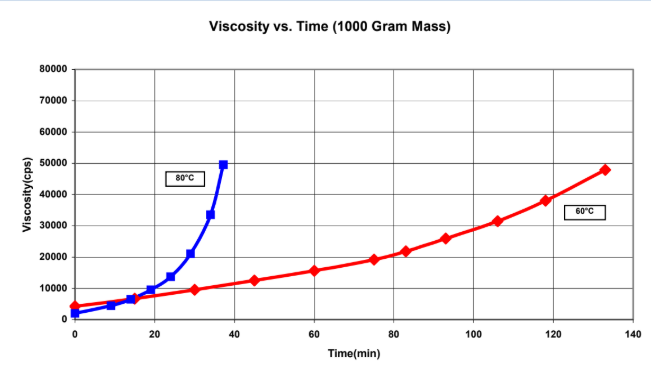
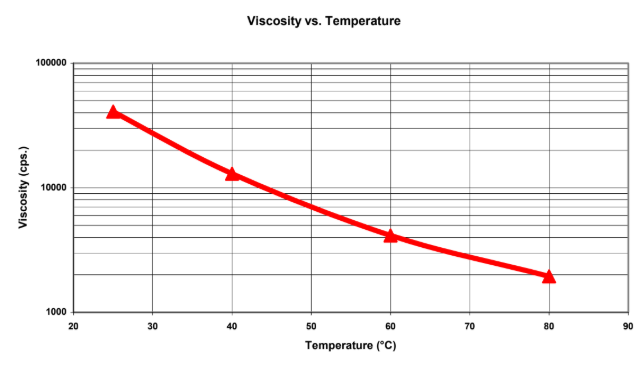
Gel time
Measurements with Sunshine Geltimer, 10 grams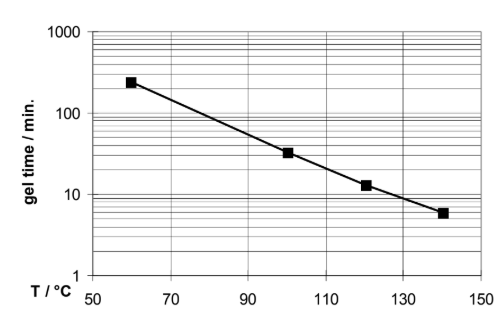
- Typical Properties
Unless otherwise stated, the data were determined with typical production batches using standard test methods. They are typical values only, and do not constitute a product specification. Data is collected on cured standard specimen at 23 °C. The specimens are cured 6 hours at 130°C.
Physical Property Test Method Unit Value Density of cured casting DIN 55990 g/cm³ 1.75 – 1.80 Glass transition temperature by DSC IEC 1006 °C 50 – 60 Flexural strength ISO 178 MPa 65 – 75 Flexural modulus ISO 178 MPa 10,000 – 11,000 Surface strain ISO 178 % 0.70 – 0.85 Tensile strength ISO 527 MPa 35 – 45 Tensile modulus ISO 527 MPa 7,700 – 8,400 Elongation at break ISO 527 % 0.45 – 0.55 Double Torsion Test (Critical stress intensity factor) PM 216-0/89 MPa·m½ 2.3 – 2.4 Specific energy at break (Gic) PM 216-0/89 J/m² (calculated) 450 – 490 Coefficient of thermal expansion DIN 53752 ppm/K 43 – 45 Limited oxygen index IEC 20-22/4 37 – 38 Fume toxicity index IEC 20-37/II 1.67 Smoke density IEC 20-37/III 0.05 Flame resistance UL 94 V0 Water absorption (10 days at 23°C, 50x50x4 mm) ISO 62 % by weight 0.27 – 0.29 Water absorption (60 minutes at 100°C) ISO 62 % by weight 0.43 – 0.45 (1) Similar formulation fulfilled the Cenelec Standard HD 464: F1E2C2
The findings of the accelerated thermal ageing test according to IEC 216 allow the conclusion that the system Araldite® CW 5942-1 Resin / Aradur® HW 5943-1 Hardener is suitable for class F applications
Electrical Property Value Test Method Breakdown, kV/mm 22.5-22.7 IEC 60243-1 Loss factor (tanδ) and dielectric constant as a function of temperature
(Measured at 50 Hz used IEC 250/ DIN 53483)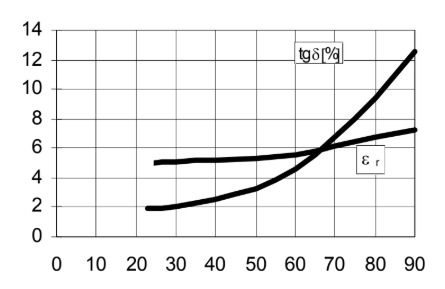
Volume resistivity (ρ) as a function of temperature
(Measured at 1,000 Volt used IEC 93/ DIN 53482)
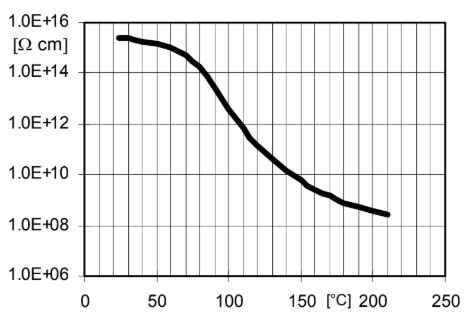
Storage & Handling
- Storage Conditions
Araldite® CW 5942-1 Resin contains some curing catalyst and / or accelerator. It should preferably not be stored for long periods at temperatures exceeding 40°C nor should it be exposed to temperatures more than 100°C for more than 2 hours. Incorrect handling will result in an increase in viscosity and reduced performance properties of the cured system.
Araldite® CW 5942-1 Resin should be stored in a dry place, in their sealed original container, at temperatures between 2°C and 40°C (35.6°F and 104°F). Under these storage conditions the shelf life is 365 days (from date of manufacture). These products should not be exposed to direct sunlight. As with most pre-filled systems, the fillers present in these components have a tendency to separate during storage. This filler separation will not negatively affect the final product properties and quality provided that both components are thoroughly homogenized prior to use. The filled components should be stirred carefully using a low shear mixer prior to processing. Do not use high speed or high shear mixers or other equipment likely to cause air entrapment.
Aradur® HW 5943-1 Hardener contains some curing catalysts and / or accelerators. Storage at elevated temperatures (>80°C) for extended periods (e.g. >5 days) will result in an undesirable increase in viscosity and will negatively affect the reactivity of the mixed system. This hardener is sensitive to moisture. Partially used containers should be closed immediately after use. Nitrogen blanketing is highly recommended as well as the use of a desiccant venting device unless the material is going to be used rapidly after opening.
Aradur® HW 5943-1 Hardener should be stored in a dry place, in their sealed original container, at temperatures between 2°C and 40°C (35.6°F and 104°F). Under these storage conditions the shelf life is 365 days (from date of manufacture). These products should not be exposed to direct sunlight. As with most pre-filled systems, the fillers present in these components have a tendency to separate during storage. This filler separation will not negatively affect the final product properties and quality provided that both components are thoroughly homogenized prior to use. The filled components should be stirred carefully using a low shear mixer prior to processing. Do not use high speed or high shear mixers or other equipment likely to cause air entrapment.
Other
- Application Information
Value Units Test Method / Conditions Mix Ratio 1.1 %(W) %(W) Hardener : Resin - Physical Properties
Value Units Test Method / Conditions Glass Transition Temperature (Tg) 50.0-60.0 °C °C Viscosity 12000.0-15000.0 cPs cPs at 40°C
